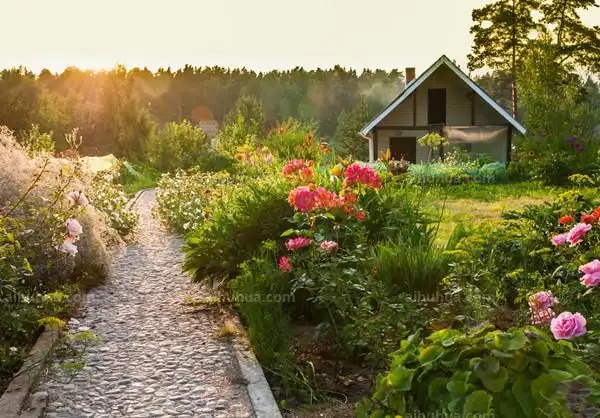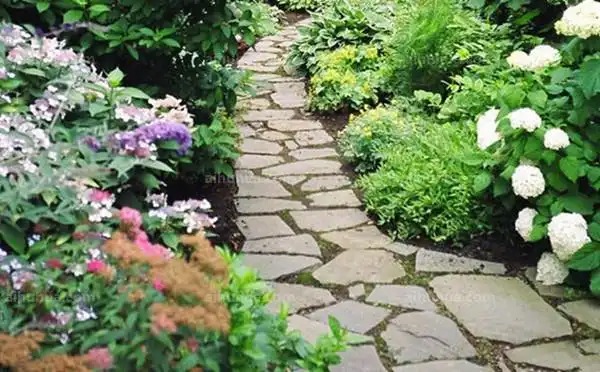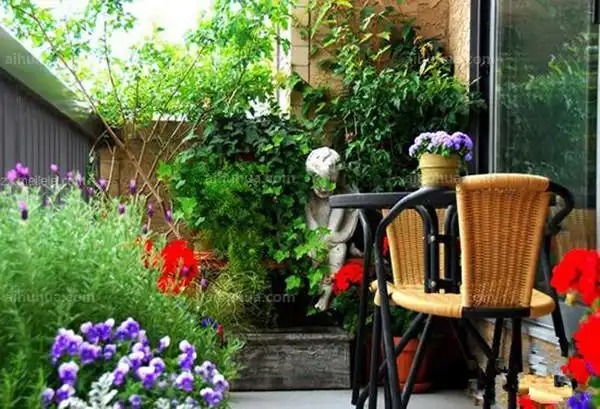Effects of temperature on flower growth

1. Temperature change law
The temperature of the earth's surface varies greatly with latitude, altitude, terrain, time, etc. As the latitude increases, the solar altitude angle decreases, the solar radiation decreases, and the temperature gradually decreases. Generally, the temperature decreases by 0.5 to 0.9°C when the latitude increases by 10 (about 111km).
Temperature also changes regularly with altitude. As altitude increases, although solar radiation increases, the atmosphere becomes thinner and the atmospheric density decreases, resulting in a decrease in atmospheric back radiation, an increase in effective ground radiation, and a decrease in atmospheric temperature. For every 100m increase in altitude, the temperature drops by about 0.5℃.
Temperature is also related to the slope. The south slope receives more solar radiation, so the air temperature and soil temperature are higher than those on the north slope. The southwest slope consumes less heat due to evaporation, so more heat is used to warm the soil and air, so its soil temperature is higher than that on the south slope. Therefore, it is better to plant sun-loving, heat-loving and drought-tolerant plants on south- and southwest-facing slopes, while it is better to plant shade-tolerant and moisture-loving plants on north-facing slopes.
The temperature changes significantly over time. Most areas belong to the subtropical and temperate zones, with four distinct seasons: spring, summer, autumn and winter. The average temperature in spring and autumn is between 10 and 22°C, the average temperature in summer is generally higher than 22°C, and the average temperature in winter is mostly lower than 10°C. The temperature also changes with day and night. Generally, the temperature is lowest before sunrise. After sunrise, the temperature gradually rises, reaching the highest around 13:00 to 14:00 noon, and then begins to gradually decrease until before sunrise.

2. Temperature requirements of flowers
Temperature is an important factor affecting the growth and development of flowers, affecting all physiological and biochemical processes in their bodies. The growth and development of each kind of flower has certain requirements for temperature, and has "three base points" of temperature, namely: the lowest temperature, the optimum temperature and the highest temperature. Due to different climatic conditions in the place of origin, the "three base points" of temperature for different flowers vary greatly. For example, flowers originating from tropical areas have a higher base point temperature for growth, generally around 18°C; while flowers originating from temperate areas have a lower base point temperature for growth, generally around 10°C; flowers originating from subtropical areas have a base point temperature between the two, generally starting to grow at 15-16°C. The optimum temperature mentioned here refers to the temperature at which plants not only grow fast, but also grow strong and not leggy. Generally speaking, the optimum growth temperature of flowers is around 25°C. Within the range from the lowest temperature to the optimum temperature, the growth speed increases as the temperature rises, and when the optimum temperature is exceeded, the growth rate decreases as the temperature rises.
Due to different climatic conditions in their places of origin, the cold resistance of different flowers varies greatly. Flowers are usually divided into the following three categories according to their cold resistance:
1. Cold-resistant flowers
Most of them are native to temperate or cold regions, mainly including open-field biennial flowers, some perennial flowers, and some bulbous flowers. These flowers are highly cold-resistant and can withstand temperatures as low as -5 to 10°C, and can even safely overwinter at lower temperatures. They can grow in the open field in most parts of the north without the need for protected land. For example, among biennial flowers, there are pansies, daisies, kale, cornflowers, snapdragons, snake-eye daisies, and rudbeckias; and perennial flowers such as hollyhocks, hostas, goldenrod, columbines, Dutch daisies, chrysanthemums, tulips, and hyacinths.
(ii) Semi-cold-resistant flowers
Most of them are native to the southern edge of the temperate zone and the northern edge of the subtropical zone. Their cold resistance is between that of cold-resistant flowers and those of non-cold-resistant flowers. They can usually tolerate relatively mild frost and can safely overwinter in the Yangtze River Basin. However, due to different species, there are also large differences in cold resistance. Some species cannot overwinter in the open field in the Yangtze River Basin or north of the Huaihe River, while some species have strong cold resistance and can safely overwinter in North China with proper protection. Common species include violets, marigolds, osmanthus, irises, amaryllis, narcissus, dieffenbachia, allium, camphor, magnolia, plum blossoms, osmanthus, and nandina. When introducing and cultivating such plants in the north, attention should be paid to introduction tests, and suitable microclimates and cold-resistant varieties should be selected. Targeted protection should be given in winter, and some species such as magnolia, camphor, and oleander should be treated with caution.
(III) Flowers that are not cold-resistant
Most of them are native to tropical and subtropical regions, including annual flowers, spring-planted bulbous flowers, cold-sensitive perennial evergreen herbs and woody greenhouse flowers. They require high temperatures during their growth period and cannot tolerate temperatures below 0°C. They will even stop growing or die at 5°C or higher. Among these flowers, annual and perennial species cultivated as annuals grow and develop during the frost-free period of the year. They are sown after the late frost in spring and die before the early frost in late autumn, such as cockscomb, marigold, saffron, mirabilis, straw daisy, aster, petunia, and verbena. Spring-planted bulbous flowers are also cold-sensitive flowers, such as gladiolus, canna, tuberose, dahlia, etc. In cold regions, they need to be harvested in autumn and stored over the winter to prevent winter frost damage. Cold-sensitive perennial herbs or woody flowers need to be protected in the north to overwinter and become greenhouse flowers.

Greenhouse flowers can be divided into three categories according to their different requirements for wintering temperature:
1. Low temperature greenhouse flowers
Most of them are native to the southern temperate zone, such as central China, Japan, the Mediterranean, and Oceania. They are semi-cold-resistant flowers. If the temperature is above 0°C during the growth period, there will be no serious frost damage, but to maintain plant growth, the temperature should be kept above 5°C. Such as primroses, freesias, violets, camellias, fuchsias, cinerarias, etc. These flowers need to overwinter in cold rooms or cold beds in North China. After the late frost in spring, they should be planted in the open field or moved outdoors. Some species can overwinter in the open field in areas south of the Yangtze River.
2. Medium temperature greenhouse flowers
Most of these flowers are native to subtropical and tropical areas with low temperatures, and require a temperature of 8-15°C during their growth period. Such flowers include Nephrolepis, Cyclamen, Hibiscus, Rubber Tree, Monstera, Bamboo Palm, White Orchid, Prunus armeniaca, Poinsettia, Pilea coccinea, etc. Most of these flowers can overwinter in the open field in southeastern and southern China.
3. High temperature greenhouse flowers
Most of these flowers are native to tropical regions and require temperatures above 15°C during their growth, which can be as high as 30°C. For most species, when the minimum temperature is 10°C, they will grow poorly or even drop leaves and die. Common species include Croton, tropical orchid, anthurium, Victoria amazonica, dracaena, cordyline, etc.

3. The influence of temperature on the growth and development of flowers
1. Temperature and growth
Temperature not only affects the geographical distribution of flower species, but also affects the different stages and periods of growth and development of various flowers. For annual flowers, seed germination can be carried out at a higher temperature, while the seedling stage requires a lower temperature. Later, as the plant grows and develops, the temperature requirement gradually increases. For biennial flowers, seed germination is carried out at a lower temperature, and the seedling stage requires an even lower temperature to facilitate the vernalization stage. When flowering and fruiting, a slightly higher temperature is required. In order for flowers to grow rapidly during cultivation, a certain temperature difference between day and night is also required. Generally, the temperature difference between day and night for tropical plants is 3 to 6°C, for temperate plants is 5 to 7°C, and for cacti is above 10°C. The temperature difference between day and night also has a certain range, and the larger the better, otherwise it will be detrimental to the growth of plants.
2. Temperature and flower bud differentiation and development
Flower bud differentiation and development are important stages in plant growth and development, and temperature plays an important role in flower bud differentiation and development. Different flower species require different temperatures for flower bud differentiation and development, which are generally as follows:
1. Flower bud differentiation at high temperature
Many flowers and trees, such as azalea, camellia, plum and cherry, differentiate flower buds when the temperature is above 25℃ from June to August. After autumn, the plants enter a dormant state, and bloom after a certain low temperature. Many bulbous flowers also differentiate flower buds at higher temperatures in summer. For example, spring-planted bulbous flowers such as gladiolus, tuberose and canna differentiate flower buds during the summer growing season, while autumn-planted bulbous flowers such as tulips and hyacinths differentiate flower buds during the summer dormant period.
2. Flower bud differentiation at low temperature
Many flowers native to the central and northern temperate zones and alpine flowers in various areas require flower bud differentiation in cooler climate conditions below 20°C. For example, some species of Hydrangea, Cattleya, and Lithops promote flower bud differentiation at around 13°C and short day conditions. Many autumn-sown herbaceous flowers such as marigolds and daisies also require flower bud differentiation at low temperatures.
Temperature also has a great influence on the development of flower buds after differentiation. The differentiation temperature of flower buds of some plant species is relatively high, and the development of flower buds requires a period of low temperature, such as some spring-flowering woody flowers. For example, tulips are treated at about 20℃ for 20 to 25 days to promote flower bud differentiation, then treated at 2 to 9℃ for 50 to 60 days to promote flower bud development, and then treated at 10 to 15℃ to promote rooting.

3. Damage to flowers caused by extreme temperatures
During the growth and development of flowers, sudden high or low temperatures will disrupt their normal physiological and biochemical processes and cause harm, and in severe cases, death.
Common low temperature injuries include chilling and freezing. Chilling, also known as cold damage, refers to the damage to plants caused by low temperatures above 0°C. It often occurs in warm-loving flowers native to tropical and subtropical southern regions. Freezing damage refers to the damage to plants caused by low temperatures below 0°C. Different plants have different resistance to low temperatures, and the same plant has very different tolerance to low temperatures at different growth and development stages: dormant seeds have the highest cold resistance, dormant plants also have high cold resistance, and growing plants have significantly reduced cold resistance. After being tempered in the cold climate of autumn and early winter, the ability of plants to tolerate low temperatures can be enhanced. Therefore, in addition to being related to their own genetic factors, the cold resistance of plants is also acquired to a certain extent under the influence of external environmental conditions. Enhancing the cold resistance of flowers is an important task. Potted flowers or seedlings cultivated in greenhouses or hotbeds must be ventilated and gradually cooled before being transplanted into the open field to improve their resistance to low temperatures. Increasing phosphorus and potassium fertilizers and reducing the application of nitrogen are one of the cultivation measures to enhance cold resistance. Commonly used simple cold prevention measures include covering the ground with sorghum stalks, fallen leaves, plastic film, setting up wind barriers, etc.
High temperatures can also cause damage to plants. When the temperature exceeds the optimum temperature for plant growth, the growth rate of plants will decrease. If the temperature continues to rise, the plants will grow poorly or even die. Generally, when the temperature reaches 35-40℃, many plants grow slowly or even stagnate. When the temperature reaches 45-50℃, most plants will die, except for a few succulent plants native to tropical arid areas. In order to prevent high temperature from harming plants, the soil should always be kept moist to promote transpiration and reduce the body temperature of plants. During the cultivation process, irrigation, loosening the soil, spraying water on the leaves, and setting up shade sheds are often used to avoid or reduce the damage to plants caused by high temperatures.